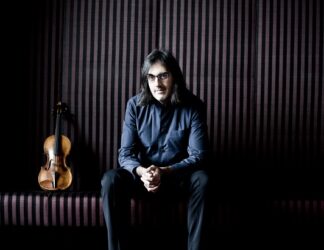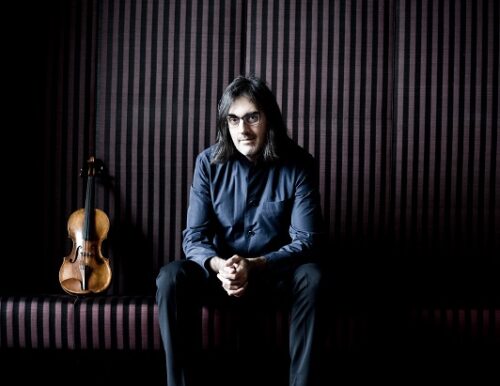 United Kingdom Beethoven, Bartók, Ravel, Franck: Leonidas Kavakos (violin), Enrico Pace (piano). Wigmore Hall, London, 22.2.2023. (CS)
United Kingdom Beethoven, Bartók, Ravel, Franck: Leonidas Kavakos (violin), Enrico Pace (piano). Wigmore Hall, London, 22.2.2023. (CS)

Beethoven – Violin Sonata No.1 in D, Op.12 No.1
Bartók – Violin Sonata No.2, BB85
Ravel – Violin Sonata No.2 in G
Franck – Sonata in A for violin and piano
In some ways, on the page this looked like an ‘old-fashioned’ sort of concert programme: a Classical ‘warm-up’, two modern sandwich-fillers, and a Romantic war-horse to conclude. Eras and styles spanned. But, there was nothing routine about this Wigmore Hall recital. In their unshowy but communicative way, Greek violinist Leonidas Kavakos and Italian pianist Enrico Pace made each of the works performed speak with an assured individuality, and the evening was thought-provoking and immensely satisfying in equal measure.
Though I’ve heard Kavakos perform on the orchestral stage many times, this was the first time I’d encountered his playing in the recital hall. He draws an intense sound from his ‘Willemotte’ Stradivarius (1734) but it’s also sensitively graded. His bowing action is silky and here the phrasing seemed innate and natural but also finely nuanced, projecting the music’s arguments convincingly. Though generally undemonstrative in manner, at times he turned his body and violin to the capacity audience, seemingly rapt and drawn instinctively to share his music directly. Pace’s performance was, for me, a revelation. The clarity and definition was stunning. Even the most complex textures and episodes of surging power were crystalline. His timbre was beautiful, his legato melodies seductively smooth. And, he seemed intuitively aware of Kavakos’s interpretative judgements in the moment. The lid of Wigmore Hall’s Steinway was raised but the balance between the duo was ever perfect.
That balance was evident from the first, in the first of Beethoven’s ten violin sonatas, Op.12 No.1 in D. As with Mozart’s sonatas, published as ‘for piano and violin’, the two instruments are equal partners and Kavakos and Pace – who recorded the complete sonatas together in 2012 on the Decca label – were entirely ‘in tune’, in every sense of the phrase. There was immense attention to detail, as Beethoven put his motifs under the microscope, surveying them from infinite angles, but also a spaciousness and grace. The opening chords of the Allegro con brio bristled with vigour, but subsequently violin and piano civilly exchanged their arguments; there was air between bow and string as Kavakos prepared Beethoven’s sforzandos, and the piano sound was bright and vibrant. The harmonic twists in the development section were persuasively articulated – this was real musical drama – and Pace’s vigorous runs were stunningly smooth. The varying moods of the Tema con variazioni. Andante con moto were cogently evoked, Kavakos’s projection subtly modulated – at times powerful and intensely focused, then more genteel and relaxed. The Rondo. Allegro had a carefree skip in its lithe step, but the duo did not neglect the dramatic tension inherent in the music.
A performance of Bartók’s Violin Sonata No.2 (1922) that was both deeply expressive and intellectually persuasive followed. Both musicians displayed a fine sense of the work’s architecture, and their pacing was such that the music seemed to grow organically to fill its ‘space’. In a 1924 letter to his concert agent, Bartók wrote, ‘The violin part of the two violin sonatas … is extraordinarily difficult, and it is only a violinist of the top class who has any chance of learning them’. The Second Sonata is not just challenging for the violinist, it demands a lot of audiences too: it’s not easy to understand its knotty arguments or appreciate its often aggressive discourse. But, while the violin’s searing glissandos and percussive pizzicatos packed a punch equal to the piano’s pounding, Kavakos and Pace found subtle shades within the Sonata’s disputatious rhetoric; motifs were finely etched, sometimes with surprising delicacy which only served to enhance the dramatic tension. And, the ending was pure poetry: stillness and quietude after all the troubled restlessness.
The unassuming virtuosity which enabled the duo to reveal a certain ‘beauty’ in Bartók’s gritty timbres and biting dissonances, allowed them to refute Ravel’s claim, in ‘An Autobiographical Sketch’, that his Violin Sonata No.2 in G was an exercise in ‘incongruity’, the violin and piano being in the composer’s opinion, ‘essentially incompatible. Far from balancing their contrasts, the Sonata reveals their incompatibility’. Here, it was the teamwork which astounded as Kavakos and Pace found an infinite range of timbres, playing with true refinement. The opening of the Allegretto had a lovely otherworldliness, Pace conjuring an airy world of pastoral myth, Kavakos’s lines trickling like water with beautiful fluidity. Glossy E-string strength contrasted with preciousness, even frailty, as the duo receded to a true pianissimo. The diversity of Kavakos’s bowing articulations was impressive – what a beguiling sautillé – but so was the sheen and lyrical power of the climax. Classicism and modernism really were integrated here. A cheekily louche quality tinted the opening of the second movement, Blues. Moderato, though the sound was always clean and purposeful. The violin’s pizzicatos were authoritative, the piano sometime droll. The imagery conjured put me in mind of Chopin. And, they made light work of the incessant racing of the Perpetuum mobile. Allegro which had a sparkling tactility that exploded like a firework at the close.
And, so, on to Franck’s Violin Sonata in A. Once again I appreciated Pace’s elegance and spaciousness at the start of the Allegretto ben moderato. Kavakos shaped the violin’s arcing phrases with real tenderness, drawing forth tonal contrasts between the lower-string meanderings and the soaring E-string melodies, and making the left-hand vibrato work hard to craft the tensions and releases, all the while a prevailing calm classicism prevailed. This movement had both grace and stature, as did the Allegro which followed segue. For once the tempo was not too pressing or reckless, so one could actually hear the voicings in the piano’s furious foraging – again attesting to Pace’s skill and clarity. And, Kavakos judged the rises and falls of expressive tension brilliantly, retreating into mystery at times then swelling back with sweetness and lyricism. The transition into the coda was superb and the duo really flew towards the climactic close. Kavakos did not overly indulge the ‘fantasy’ element of the Recitativo-Fantasia. Ben moderato – there was less rubato and freedom than is often the case – but the ending was beautifully dreamy and just right as it slipped segue into the Allegretto poco mosso, the tempo of which was fairly swift, though the phrasing established an air of tranquility. The duo roved through the harmonic shadows persuasively and made theatre of the return of Franck’s glorious theme.
This was not flamboyant playing: both musicians wear their virtuosity lightly. But, neither was it introspective. The audience at Wigmore Hall were resoundingly appreciative. The relaxed geniality of the second movement of Schubert’s ‘Grand Duo’ D574 made for a perfect encore.
Claire Seymour

I was there for this recital and thought these two had a chemistry going that produced something a bit special. I have seen Kavakos and Wang perform here and although they are obviously top draw, this performance was exceptional. I might stand corrected, but I think at the end Kavakos said “I can see you’re not going home before we have played some more”, which summed up the evening perfectly.
I agree, I was there (that one with Yuja as well). I can feel he shares a lot of things with Yuja. But this time with Pace in these heavy repertoires they have brought us more with their amazing chemistry. Absolutely speechless.
I was at the same program in Barcelona on March 3, 2023 and they (Leonidas and Enrico) played an encore the third movement from the same Schubert piece. It was so sweet and extraordinary.